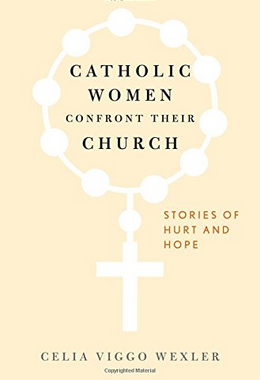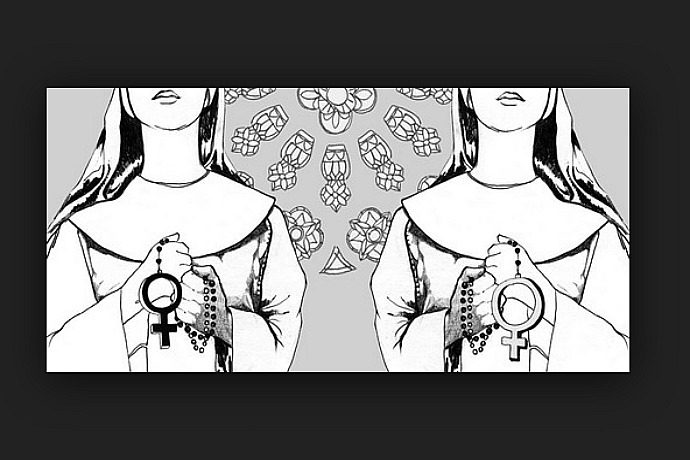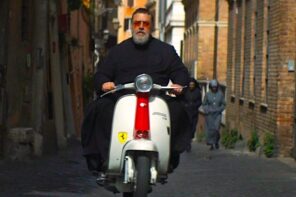In her latest book, journalist Celia Wexler explores the conflicted feelings many Catholic women have towards their faith and the attempts to make peace with the institutions and traditions that fail them.
What inspired you to write Catholic Women Confront Their Church: Stories of Hurt and Hope?
I often say that I wrote this book for my daughter, Valerie. She is a terrific young woman, bright, independent-minded, fiercely feminist, and an atheist. Despite my best efforts—I baptized her, took her to Sunday Mass, answered her questions about my faith—she just was not drawn to Catholicism. I think the fact that her baptism never “took” was in part because my spouse is a committed Jewish atheist. So she could see that someone could live a fully ethical life and not have religious faith. But I worried that I also had failed, because of my own complicated feelings about Catholicism. I felt a lot of guilt about her upbringing.
At the same time, I was having my own crisis of faith. The papacy of Pope Benedict XVI in particular was trying. He had such a dour world view. He changed the prayers we say at Mass, and made them less personal and more remote. Even American priests did not like the new translation he approved. Benedict’s Vatican also scolded the Leadership Conference of Women Religious, which represents tens of thousands of U.S. nuns, for its “radical feminist” agenda. In essence, the Vatican chastised the sisters for caring more about the poor and marginalized than they did about the bishops’ obsession with birth control, abortion and homosexuality.
Of course, I, like millions of other Catholics, also was disgusted by the priest pedophilia scandal, and the church’s attempts to cover it up.
But there were so many aspects of Catholicism that I valued. As I wrote in my book:
There is no doubt that my life has been enriched by the gospels, the stories of the saints, the world’s cathedrals, and the solemn and spiritual liturgy of the church. I don’t want to appreciate the church’s music, art and history as a disinterested spectator. I want more. But that’s where the struggle comes in. I cannot reconcile my conflicted feelings for the church I cannot bear to leave.

Catholic Women Confront Their Church: Stories of Hurt and Hope
Celia Wexler
Rowman and Littlefield Publishers
September 2016
After years of angst over my faith, I had come to a fork in the road. I did not know whether I could continue to be both a feminist and a practicing Catholic. As a journalist, when I’m conflicted, I tend to write books. My first book explored my conflicted feelings about my profession. I wrote Out of the News: Former Journalists Discuss a Profession in Crisis. That book told the story of journalism’s tumultuous recent past and uncertain future through the lens of personal experience.
I would use a similar approach for this second book. My plan was to seek out Catholic women who shared my progressive views and feminism and ask them to tell me about their own struggles with the church. I did not have an agenda. I just wanted to know whether the term “Catholic feminist” was an oxymoron. The book also would give me the opportunity to tell the history of the church since Vatican II through the lens of their individual stories.
I knew that if I asked other women to share their deepest feelings about their faith, I would have to tell my story too. That was the first “chapter” I wrote. Nevertheless, I continued to remain unsure about this enterprise, and wondered whether I could take on a project that would be so emotionally wrenching for me.
To reach a decision about the book, I participated in the Key West Literary Seminar’s Writers Workshop Program in January 2013. I shared my chapter in a memoir writing workshop led by Pulitzer Prize-winning journalist Madeleine Blais. I knew my husband liked the chapter, but I had no idea what others would think. I had never written anything so personal. I so feared exposure that I came close to bolting before I introduced my chapter to the class. But Maddie and my colleagues in the group were so supportive and helpful that I was encouraged to move forward.
What’s the most important take-home message for readers?
At its core, this book is about faith—getting it and keeping it. It speaks to the journey many of us take, trying to resolve our conflicted feelings and to make peace with institutions that fail us. Do we abandon them, or try to reform them? How do we find a way to maintain our integrity while continuing to belong to institutions that, although flawed, have great emotional value to us, that are a part of us? It says to Catholic women that you can be Catholic and feminist, if you are willing to be Catholic on your own terms.
The nine exceptional women I profiled are the heart of the book. They include high-profile Catholic activists such as “Nun on the Bus” Sister Simone Campbell; Barbara Blaine, herself a sexual abuse survivor and the founder of the Survivors Network of those Abused by Priests; Marianne Duddy-Burke, the executive director of DignityUSA, which advocates for LGBT Catholics, and Frances Kissling, who served for 25 years as the head of Catholics for a Free Choice, now Catholics for Choice.
But in these pages you’ll also meet an African-American convert and theologian who did some of the first research on Georgetown University’s slave-holding past, as well as a Latina sexual ethics professor who found that guiding her struggling students helped her come to terms with her own rape as a teenager. One of my subjects—now a gifted and prolific writer—spent her childhood with a mentally ill Catholic mother, cycling in and out of homeless shelters. Another, a Belgian-born academic, found her European Catholicism marginalized at that bastion of American Catholicism, Notre Dame. A former nun married to a former priest now finds God in the work she does as a psychotherapist.
In one way or another, each woman struggled with the institutional church and its relationship to her own spirituality and Catholic identity. They taught me that as Catholics, women do not surrender their free will or their ability to make moral decisions based on their own consciences. I learned that the institutional church—what Duddy-Burke terms Catholic, Inc.—is a fallible structure, still grappling with sexism, racism and homophobia. I grew to understand that faith can survive and prevail, even when institutions fail us.
Writing this book brought me into contact with dozens of other Catholic women who face similar struggles, but keep their qualms to themselves. It made me realize that I was not alone.
Is there anything you had to leave out?
After writing the stories of the nine exceptional women in my book, I’ve met so many more women with equally fascinating stories. I wish all of these women could have been part of the book, although it probably would have doubled in size!
The book does not aim to be comprehensive, but through the stories of the women I profiled, it does touch on nearly every issue dividing the church today: the ordination of women to the priesthood, the U.S. bishops’ obsession with abortion and the contraception mandate in the Affordable Care Act, the priest sex abuse scandals, and the church’s position on homosexuality.
The only issue I would have liked to have discussed in the book is the question of divorce and remarriage, and how the church addresses—or fails to address—the situation of remarried divorced Catholics as well as Catholic women who feel betrayed when their spouses receive annulments.
What are some of the biggest misconceptions about your topic?
A number of conservative Catholics believe, erroneously, that being a Catholic is like being in the army, you follow orders, no questions asked. But the church has never required that its followers obey and believe mindlessly. It’s always respected the role of conscience in forming our faith and guiding our moral decisions.
These same conservatives are threatened by feminism, since the idea that women are entitled to equal power in the church upsets the institutional structure where power is concentrated in men ordained to the priesthood, isolating the laity—including women religious.
Writing this book has given me the courage to “own” the label, “cafeteria Catholic.” I contend that as Catholics, we are supposed to live according to the dictates of our conscience, informed by the church. We aren’t supposed to blindly obey, and merely check all the boxes that show we’re in lockstep with the positions of the U.S. bishops.
Living according to our conscience is far more demanding. We must examine our conduct and whether it measures up to the message of the gospel. We must work to make the world more just, and serve the poor and the marginalized.
Did you have a specific audience in mind when writing?
My first audience was myself. I was on a quest, and sought out Catholic women I respected who agreed with my progressive views and could help me figure out what to do in my own life.
But as I began to write, I realized that I wanted to reach Catholic women in the pews, the people I call Catholic “everywomen.” They are not activists, but they are not mindless followers either. They attend Mass, but find the sermons uninspiring. They often disagree with the church on birth control and the criminalization of abortion, but they keep their views to themselves.
I want them to begin talking to one another. I want to launch a conversation, actually thousands of conversations. My dream is that scores of women discuss this book over coffee or wine and find some comfort in it.
I never expected that my audience also would include feminist theologians. Theologian Mary E. Hunt has been one of my strongest supporters. Certainly these experts don’t need my insights on liberation and womanist theology.
I think what they appreciate is my ability to discuss the history of the church over the past half century through the lens of a Catholic everywoman. Since the book was published, many women have come up to me and told me how much it resonates with their own experiences and reflects their own frustrations. I’ve heard that some women have stayed up all night reading it!
That said, this book is meant for any woman who is grappling with faith and feminism, regardless of her faith. Certainly sexism bedevils many religions—Orthodox Judaism, Islam, evangelical Christianity and Mormonism.
Are you hoping to just inform readers? Entertain them? Piss them off?
I want to both inform, comfort and inspire my readers. At the heart of this book are the nine exceptional women who shared their stories with me. They make the book. I want to introduce them to the world. Even those women who are well known, such as Frances Kissling, reveal new dimensions. For example, I was struck by how nuanced Frances’ position on the ethics of abortion is. She is not the two-dimensional church foe painted by her critics.
The book offers women a first-aid kit for souls damaged by the routine misogyny in the institutional church. I want them to know they are not alone. I have no idea whether church leaders will ever read the book, but my afterword addresses the consequences for Catholicism if the sharp decline in the participation of young women in Catholicism continues. The church will lose women who question authority, are independent-minded, and committed to social justice. That would be a great loss to the church.
What alternative title would you give the book?
I had considered the title, “When faith and feminism collide.” I also had proposed to my editor the title: Catholic Women Confront Their Church: Stories of Anger, Hurt and Hope. But “anger” got cut, likely for the alliteration. I regret that change only because anger definitely plays a role in the stories of the women I profile. It is difficult not to be angry when you’ve grown up in a church that so devalues your autonomy and talents.
How do you feel about the cover?
My daughter actually suggested a cover concept that looks remarkably like the book cover the publisher came up with. I think it’s subtle. The rosary suggests Catholicism, but the design also very much hints of the symbol we use to represent the female gender. I definitely did not want a church or a prelate on the cover! I think this works.
Is there a book out there you wish you had written? Which one? Why?
If there is one book I wish I had written, it would have been Mary Pipher’s Reviving Ophelia. That book, published in 2005, was groundbreaking in its empathetic exploration of adolescent girls and their challenges. It used the power of storytelling and personal narrative to expose systemic and cultural problems.
Po Bronson wrote What Should I Do With My Life? in 2002. That book also taught me the power of personal stories to inspire and illuminate.
What’s your next book?
My next book will be about my maternal and paternal grandparents, and their respective experiences as Italian immigrants. The families of my mother and father contain enough drama to sustain any narrative arc. The book will also examine immigration through the lens of personal history.





